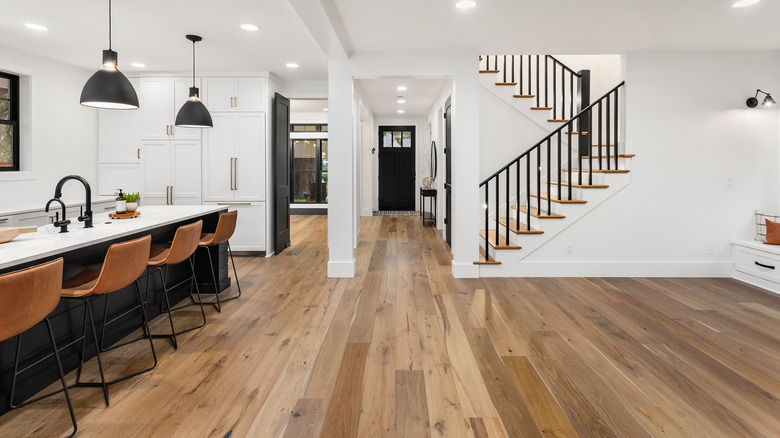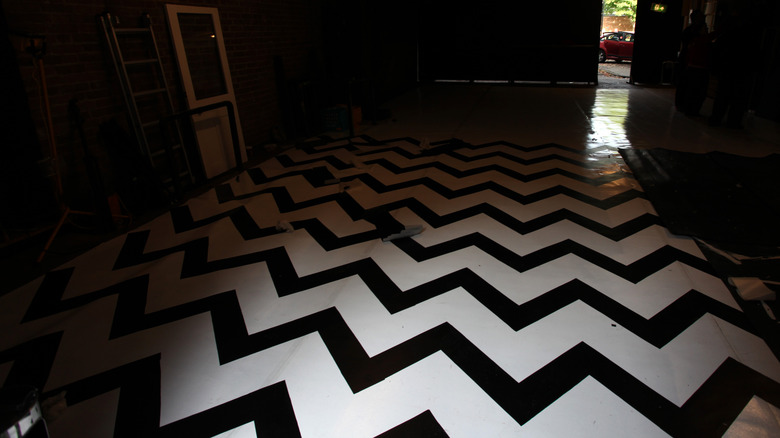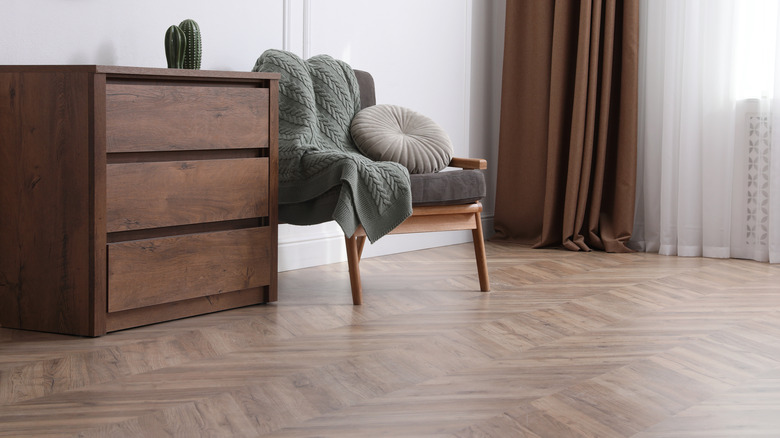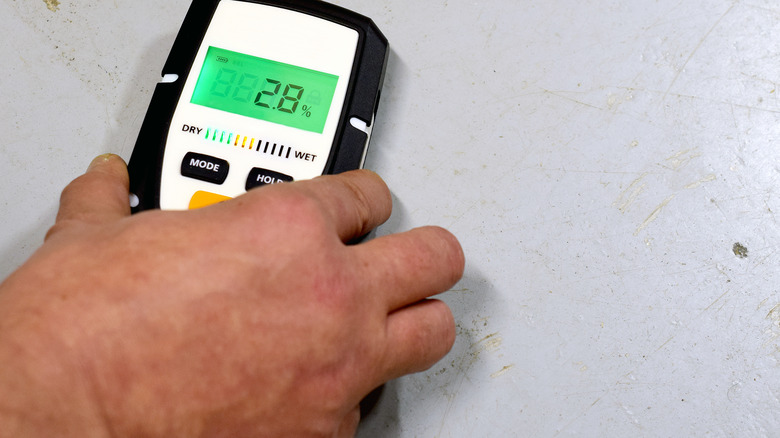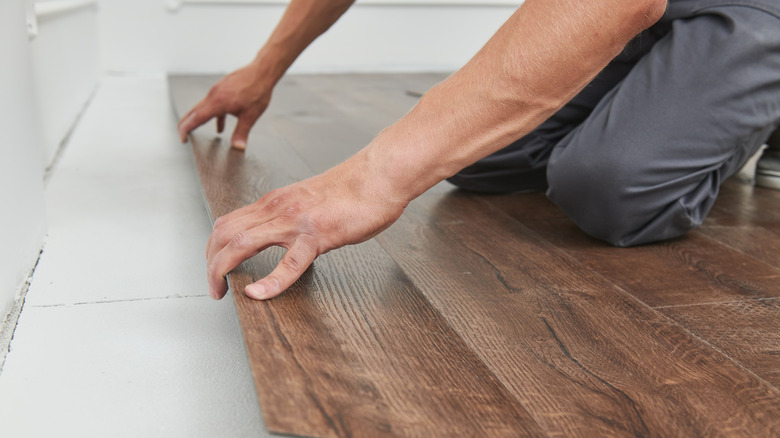Mistakes People Make When Flooring Over Existing Floor
It seems simple — instead of pulling up your old floor, you merely install a new one over it; it's less fuss and your end result looks clean, unmarred, and beautiful. If only that reality existed all the time. Unfortunately, there are rules for attaching your new flooring to the old one ... and it's not always possible to do so.
In some cases, putting the new flooring over the existing layer only causes problems, like a greater likelihood of squeaking, according to Phillips Floors. Floor height also can plague you. Some homes, like older houses, aren't equipped for thick flooring and you'll have doors that won't close, trim that looks short, and appliances that no longer fit under the counter space.
Another problem is that the old flooring weakens the new one — and some manufacturers will nullify their warranty if you apply it this way. However, if you scout the room and see no potential height problems, the old flooring is structurally sound, or you have asbestos underneath the old material that you're wary of moving, there are some products that work well over existing floors. Some of these include laminate, interlocking luxury vinyl tile, or interlocking wood. These floating floors are usually secured with trim or end molding. Still, before installing these, there are a few things you must consider, like whether you'll go DYI — and, if so, be honest about your skill set, as floor installation is an advanced project — or hire a contractor.
Consider multiple estimates if hiring a flooring contractor
An old adage says you get what you pay for, and there is some truth in that. While it's tempting to choose the cheapest vendor, you need to consider more than price. The Flooring Girl points out that price equals labor, material, and scope of work. If a contractor is offering a much lower price, they may provide you with lower-quality material or inferior workmanship. Always ask why they can offer below-market prices — do they work independently? Have an in with a supplier? Do they do two coats of poly or three? You don't want to hire someone who lowballs estimates and then doesn't deliver.
Research the contractors you're thinking of hiring by checking their references and looking at online reviews. It's always good to get referrals from friends and family — and then you can see exactly what the work was like when you visit their homes. Most importantly, make sure all work expected is written specifically in the proposal and quote, including every detail about the job — like who is arranging for any needed permits, work times, clean up expectations, payment schedule (never pay more than 10-20% of the project for your initial deposit), and the vendor's contact information, said Make It Right. If you see anything that's vague, that's a red flag for potential problems and you should ask the contractor to clarify those points in writing. Forget about those handshake contracts, even if you're working with someone you know.
Don't forget to line the flooring up properly
With flooring, installation is everything. The first step in creating fabulous floors is ensuring that everything is aligned properly because small mistakes will be obvious. Older homes are especially difficult; after so many years, the house has settled and the corners may not be 90 degrees anymore. A good contractor should spot any inconsistencies and adjust for the discrepancy.
If you are going to DIY route, this is something you want to look out for and then brainstorm solutions before you start laying down flooring. You also want to pay attention to the pattern as you do the work. If you are alternating tiles, get into the habit of checking what you're doing with each segment. One misplaced tile mars an entire floor; it's easy to fix one if you recently made the error. Tearing up an hour's work, though, is something you certainly want to avoid, notes PermShield.
Measurement is also important, so embrace the saying measure twice, cut once, according to Redfin, whether you are doing the installation or a contractor is. Remember, you want to ensure that enough flooring is ordered initially so you can install the floor and have some extra for breakage and mistakes. But you also don't want oodles of boxes that hog up your closet space for years.
Don't choose style over function
It's always fun to look at flooring trends and choose something a bit different that resonates with the time period — but flooring stays down for a while. It's not like those decorative pillows on your couch that you swap out every time the seasons change. There's something about going classic (like these parquet floors above).
So while your personal style should be considered when shopping for your floor's new look, think about how the new floor might fit into your daily routine, according to Help from Friends. A well-used area might indicate you need something that stands up to that regular wear rather than a luxury flooring that might be better suited for the formal dining room, which you only use on holidays and special occasions.
Consider, as well, things like mold and trim — will you need to remove and reinstall them? Or purchase new enhancements that match the new flooring? Will the new flooring impact a companion room so you'll need to think about transitional material so people won't trip as they move from place to place, asks Redfin?
Don't forget to check moisture levels
Checking the moisture levels before installing flooring is always a smart thing to do, especially if you're working with already warped and damaged materials or in a basement. First, inspect the old flooring for any signs up moisture — does it buckle in spots? Do you see any mold or mildew? Additionally, vet several sections of your room with a moisture meter and see how they compare to levels that flooring manufacturers recommend. If the moisture is too high, you might have to seal the floor before any installation occurs, as noted by Help from Friends.
Certain materials, like laminate flooring, require a specific humidity: no more than 60% and never going under 30%. When humidity rises above that point, the floor expands and can cause planks to buckle. Low humidity makes the same flooring shrink and can cause planks to separate and gap. Of course, you want neither of these things to happen. There are a few things you can do to address this, so research the materials of the flooring you want to use to ensure it's appropriate for the space. For instance, acclimating laminate flooring for 48 hours helps the planks adjust to your home's humidity level (via Best Laminate).
Don't use the wrong tools when installing your flooring
Before starting a floor installation, you'll need to decide how you will attach the new floor on top of the old one. Will you use glue? If so, what type? Maybe nails might work better for the project? There is not a one-size-fits-all answer for this. If you use glue, you'll need to know what surfaces you are working with since certain adhesives are not appropriate on existing sheet vinyl, or vinyl and cork tile, according to Hopkins Carpet One. It always pays to consult the manufacturer's suggestion on appropriate adhesives or if underlayment (a thin layer that goes under flooring to supply insulation and sound absorption) is needed.
Nailing down flooring is cost-effective and quick, but if you use this method on hardwoods, the nails can loosen and produce squeakiness in time, according to Panel Town & Floors. So that's something you should consider.
Installing new floors is a wonderful way to rev up your home's décor, but before doing so make sure you do your research and select the best materials for the needs you have ... and maybe hire a contractor to help you along the way.
